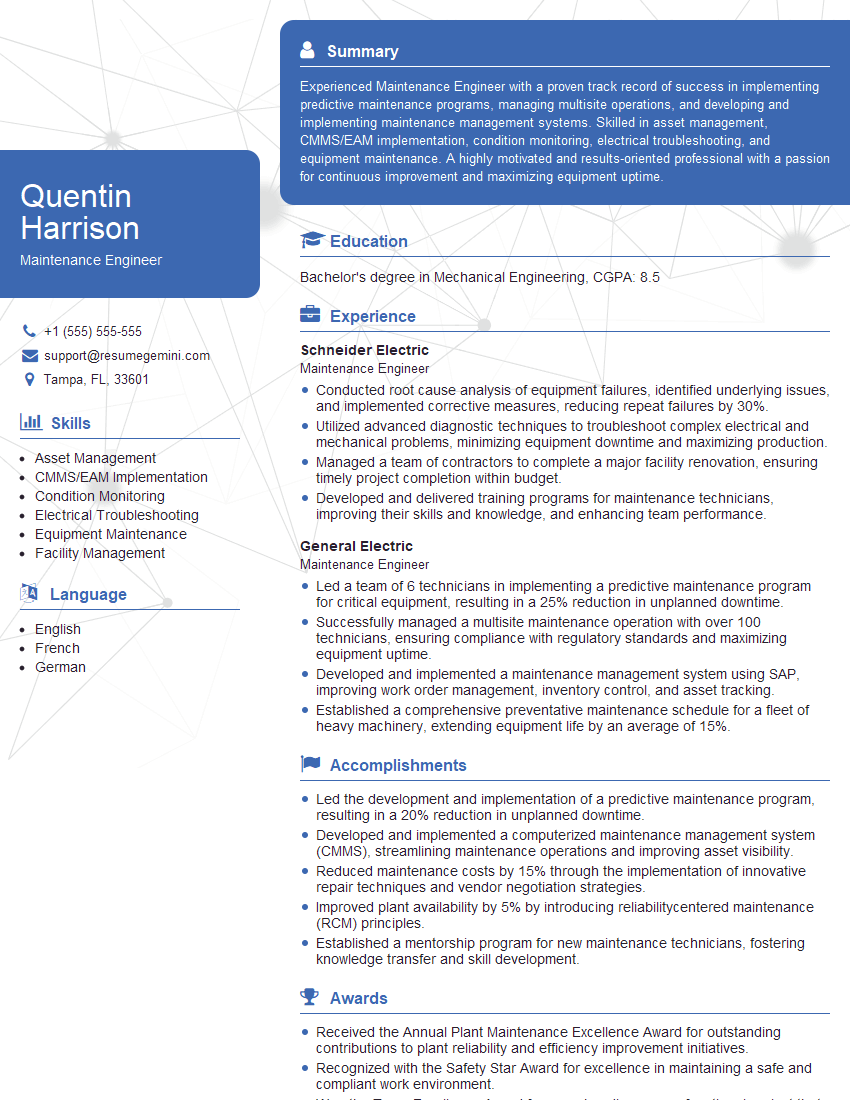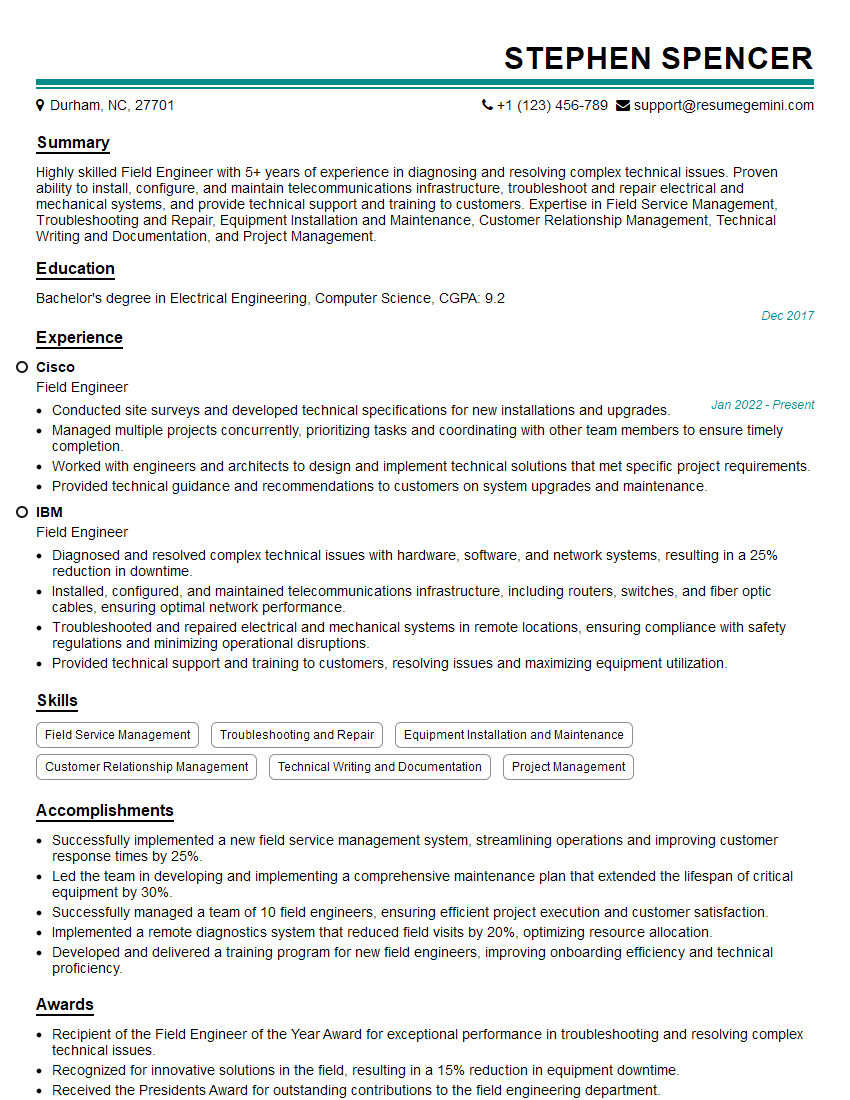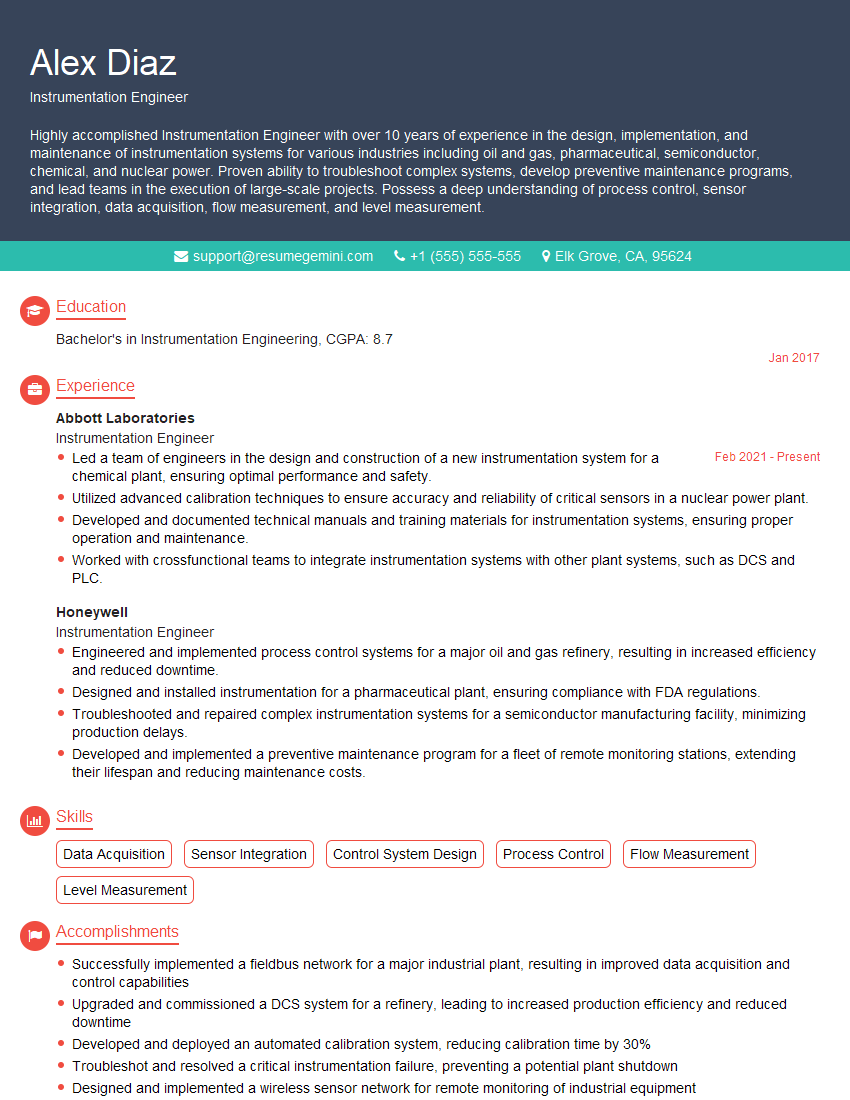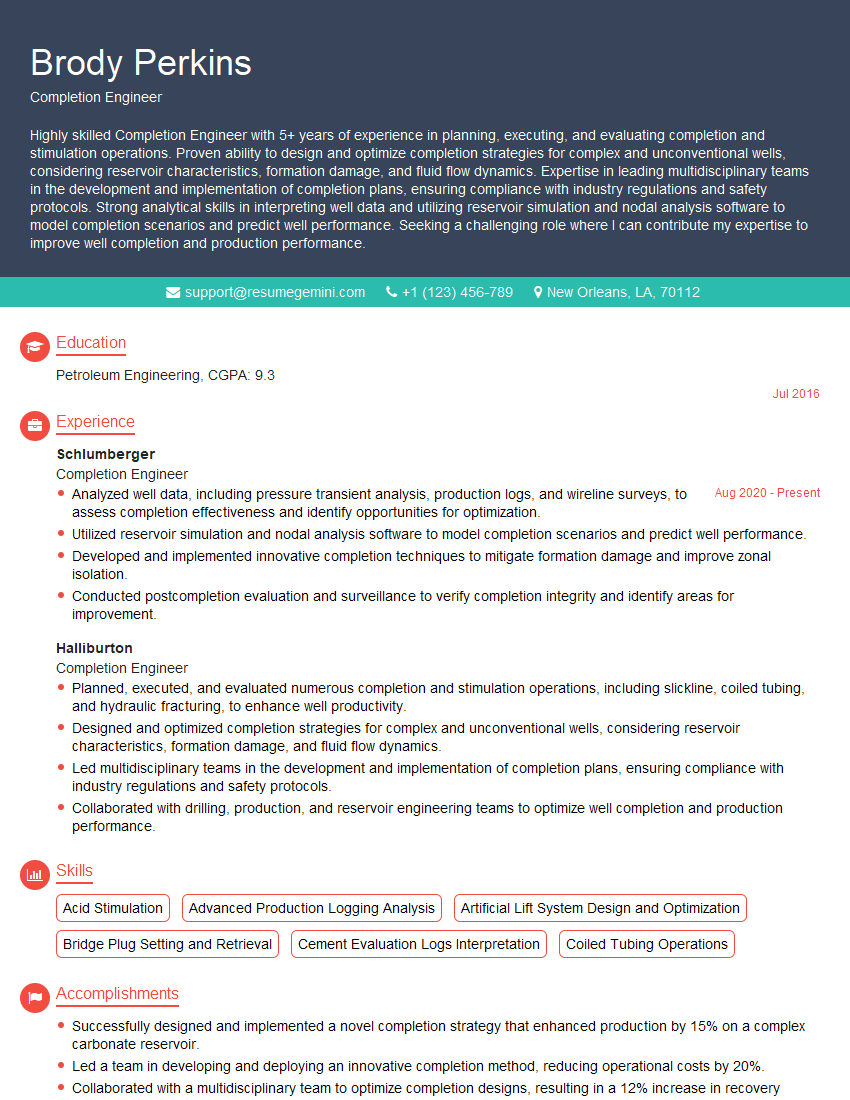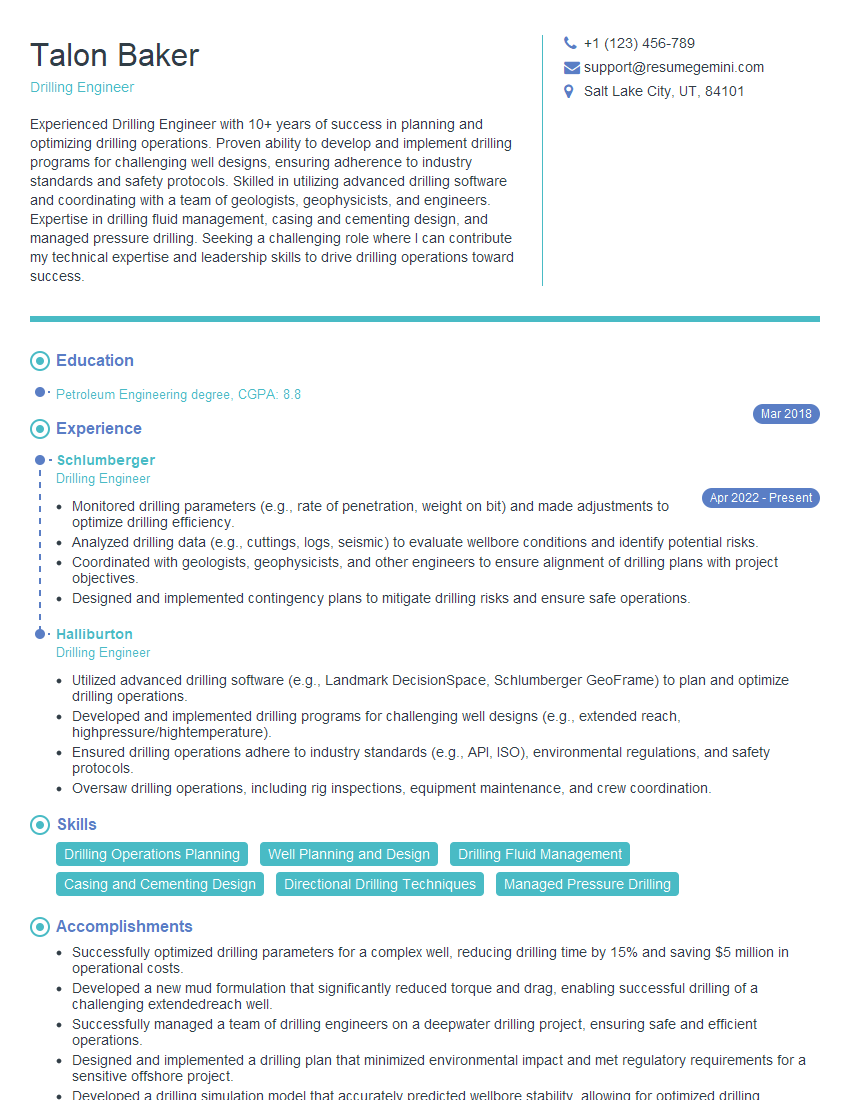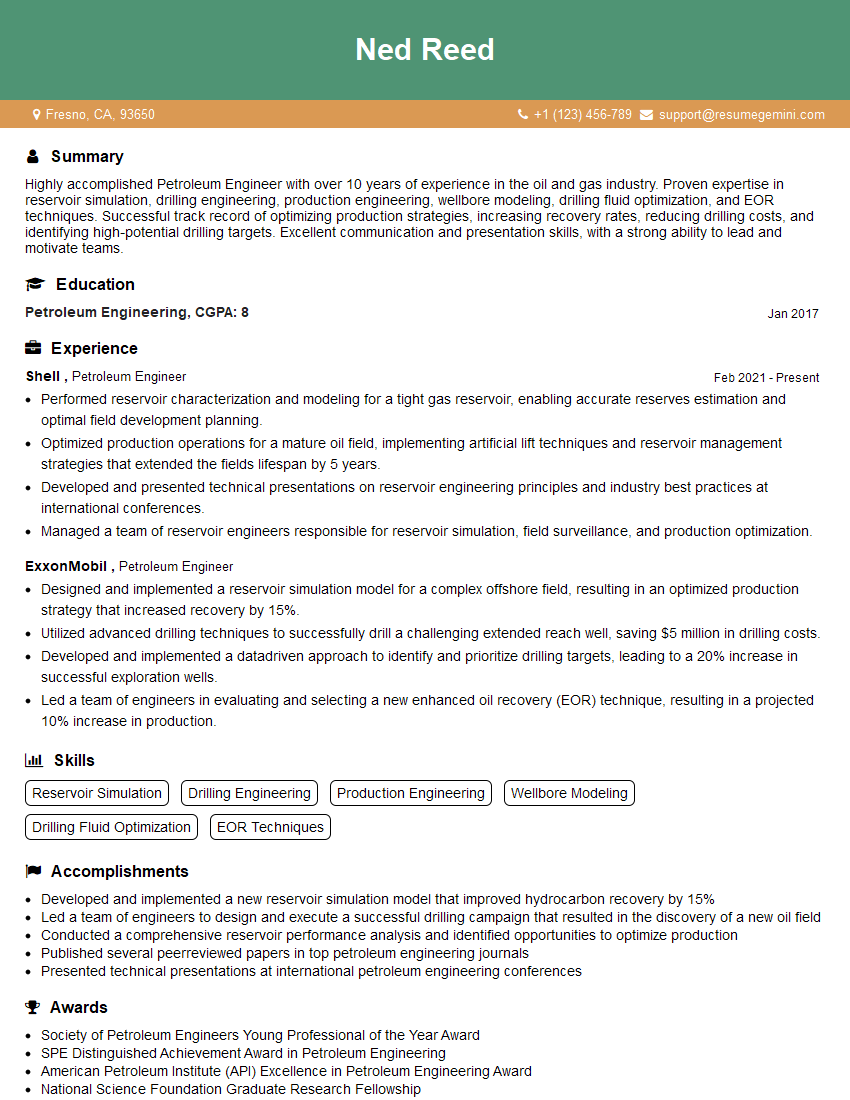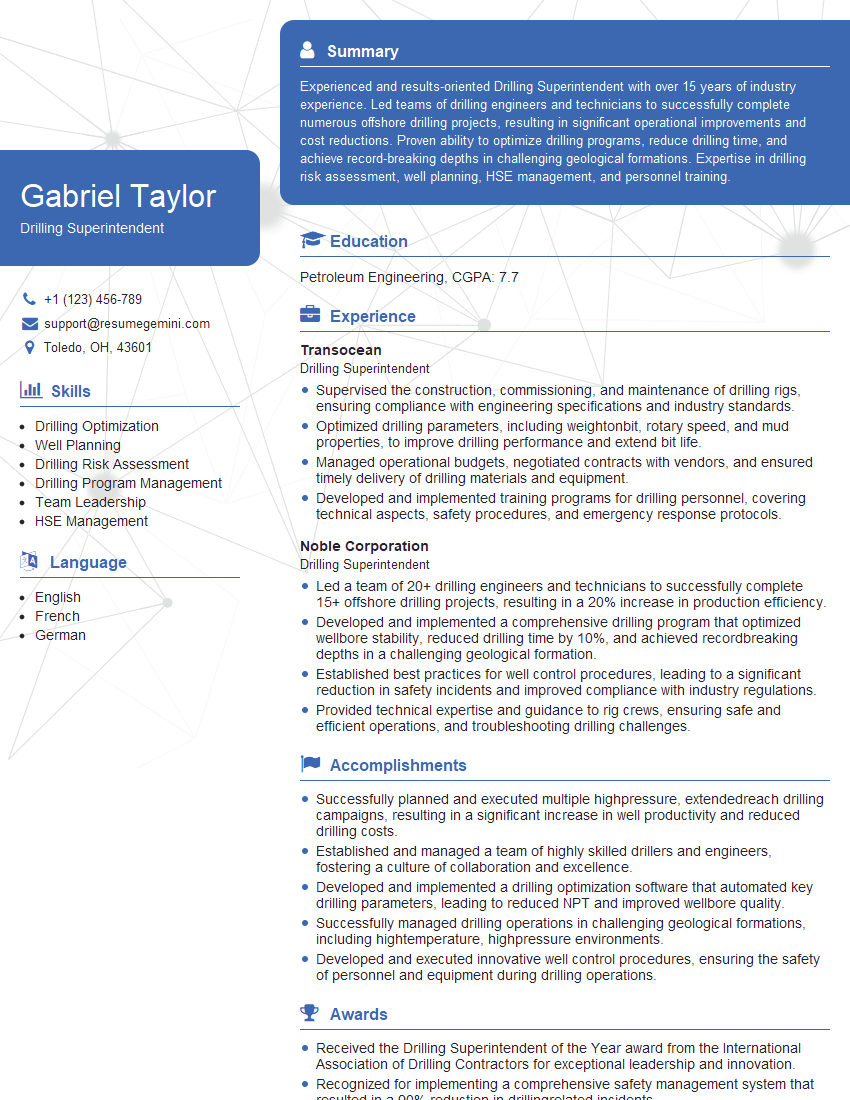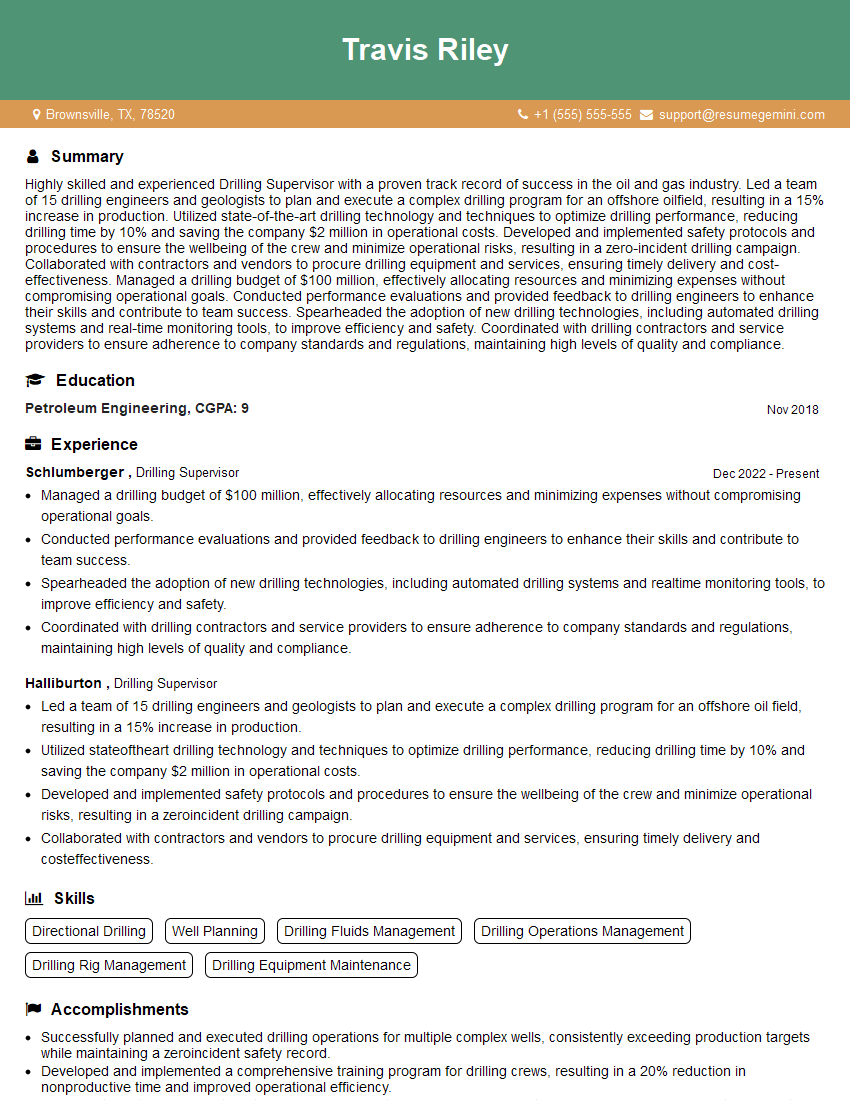Are you ready to stand out in your next interview? Understanding and preparing for Casing Replacement Procedures interview questions is a game-changer. In this blog, we’ve compiled key questions and expert advice to help you showcase your skills with confidence and precision. Let’s get started on your journey to acing the interview.
Questions Asked in Casing Replacement Procedures Interview
Q 1. Describe the different types of casing failures.
Casing failures can be broadly categorized into several types, each demanding a different approach to remediation. Understanding these failures is crucial for effective well intervention planning.
- Collapse: This occurs when the casing’s structural integrity fails due to external pressure exceeding its compressive strength. Imagine a soda can crushed under pressure – that’s essentially what happens here. This often results in a severely deformed casing string.
- Buckling: Similar to collapse but often involves a more localized deformation. The casing may bow or bend, impacting its ability to provide support and sealing.
- Corrosion: Chemical reactions within the wellbore environment can weaken the casing over time, leading to pitting, perforation, or even complete failure. Think of rust on a metal pipe – this slowly weakens the material, reducing its lifespan.
- Fracture: This involves the casing breaking due to excessive tensile or compressive stresses. This can result from high pressures, impacts, or poor installation.
- Leakage: This is a failure of the casing’s sealing function, allowing fluids to migrate between different zones. This can range from small leaks to major fluid loss, affecting production or creating environmental concerns.
Identifying the specific type of failure guides the selection of appropriate repair or replacement strategies.
Q 2. Explain the process of identifying a failed casing string.
Identifying a failed casing string requires a multi-pronged approach that combines data analysis and physical inspection. Here’s a breakdown of the process:
- Pressure Testing: This is the most common method. We isolate sections of the casing and pressure test them. A pressure drop indicates a leak. For example, a pressure test revealing a significant loss in pressure between two packers indicates a leak in that section of the casing.
- Temperature Surveys: Abnormal temperature profiles can suggest fluid movement and point towards a casing leak, particularly if a temperature gradient is inconsistent with expected geological conditions.
- Cement Bond Logs: These logs assess the quality of the cement bond between the casing and the formation. A poor bond can compromise the casing’s ability to withstand external pressures and can indicate a potential failure point.
- Caliper Logs: These logs measure the casing diameter. Significant deviations from the expected diameter indicate deformation, collapse, or buckling.
- Video Logs: Visual inspection, using specialized downhole cameras, allows direct observation of the casing’s condition, revealing corrosion, fractures, or other damage.
Combining these methods provides a comprehensive assessment of the casing’s condition and pinpoint the location and nature of the failure.
Q 3. What are the common causes of casing collapse?
Casing collapse is a serious issue stemming from various factors. Understanding these causes is paramount to preventative maintenance and effective well integrity management.
- High External Pressure: Increased pressure from formations surrounding the casing, often due to changes in pore pressure or formation compaction. This is analogous to the pressure a submarine hull experiences at great depth.
- Poor Cementing: Inadequate cementing leaves gaps between the casing and formation, reducing support and increasing the risk of collapse. A weak cement bond is like trying to build a house on a weak foundation – it’s unstable and prone to failure.
- Corrosion: Chemical reactions erode the casing’s metal, weakening its structure and reducing its ability to withstand pressure.
- Differential Pressure: Significant differences in pressure between the inside and outside of the casing. This can happen if there’s high pressure in the formation surrounding the casing and relatively lower pressure inside the casing.
- Thermal Stresses: Fluctuations in temperature within the wellbore can induce significant stresses on the casing, contributing to failure.
- Mechanical Damage: This can occur during drilling, completion, or workover operations – improper handling or unforeseen incidents can damage the casing directly.
Mitigating these risks through proper design, construction, and monitoring is crucial in preventing casing collapse.
Q 4. Outline the steps involved in planning a casing replacement operation.
Planning a casing replacement is a complex undertaking requiring meticulous attention to detail and safety. The planning process generally involves these steps:
- Well Assessment: Thoroughly review well logs, pressure tests, and other data to define the extent of the damage and identify the failed section.
- Engineering Design: Determine the required size, grade, and length of the replacement casing, considering well conditions and future operational plans. This will involve detailed calculations and simulations to ensure the new casing can withstand anticipated pressures and stresses.
- Resource Allocation: Secure necessary equipment, personnel, and materials, including specialized tools for running and cementing the new casing string.
- Risk Assessment: Identify and mitigate potential hazards associated with the operation, including well control issues, H2S exposure, and potential environmental impacts. A comprehensive risk assessment is crucial for a safe and efficient operation.
- Logistics Planning: Coordinate transport, storage, and handling of equipment and materials. This also includes planning for potential delays or unexpected situations.
- Procedure Development: Develop a detailed step-by-step procedure outlining every aspect of the operation, including contingency plans for unexpected events.
- Regulatory Compliance: Ensure the operation adheres to all relevant safety regulations and environmental guidelines.
Careful planning directly impacts the success and safety of the operation.
Q 5. What are the safety precautions necessary during a casing replacement procedure?
Safety is paramount during a casing replacement procedure. Several key precautions must be taken:
- Well Control: Maintain well control at all times to prevent uncontrolled flow of fluids.
- H2S Monitoring: Monitor for the presence of hydrogen sulfide (H2S), a highly toxic gas commonly found in oil and gas wells. Use appropriate safety equipment and procedures.
- Personal Protective Equipment (PPE): All personnel must wear appropriate PPE, including hard hats, safety glasses, and protective clothing.
- Emergency Response Plan: Have a detailed emergency response plan in place to handle any unforeseen events.
- Rig-Site Safety Procedures: Adhere strictly to all rig-site safety procedures and regulations.
- Competent Personnel: Employ experienced and qualified personnel to conduct all aspects of the operation.
- Regular Inspections: Conduct regular inspections of equipment and working conditions to identify and address potential hazards.
A proactive approach to safety is vital throughout the operation.
Q 6. How do you determine the appropriate size and grade of replacement casing?
Selecting the appropriate size and grade of replacement casing involves several factors.
- Wellbore Conditions: Analyze the well’s geometry, including the existing casing diameter and the condition of the borehole. The new casing must fit correctly and adequately fill the wellbore section. This also involves considering the well’s depth and planned service life.
- Pressure and Temperature: Determine the anticipated pressures and temperatures the casing will experience. The casing grade must be sufficient to withstand these conditions without failure. We use specialized software to perform these calculations, ensuring the chosen casing has an adequate safety margin.
- Formation Properties: Consider the strength and stability of the surrounding formations. If the formation is unstable, a heavier grade of casing may be required to prevent collapse. This frequently involves evaluating past wellbore instability issues.
- Operational Requirements: Take into account the planned future use of the well. For instance, a higher-pressure well will need a more robust casing compared to a low-pressure well. We will design the casing to tolerate future injection or production pressures as required.
Choosing the correct casing ensures the longevity and safety of the well.
Q 7. Explain the process of running a new casing string.
Running a new casing string involves a series of carefully coordinated steps:
- Preparation: Prepare the wellbore by removing any obstructions and ensuring a clean path for the new casing.
- Casing Running: Carefully lower the new casing string into the wellbore, using appropriate equipment to guide and control its descent. This often uses specialized equipment to prevent damage to the casing string and existing well infrastructure.
- Casing Centralizer Placement: Position centralizers along the casing to ensure concentricity and prevent eccentricity, allowing for a uniform cement placement.
- Cementing: Pump cement slurry into the annulus (the space between the old and new casing) to provide support and seal the casing. Careful monitoring of the cementing process is crucial to ensure proper placement and bond.
- Displacement: Displace the cement slurry with drilling mud, ensuring a complete and effective cement bond between the new casing and the formation.
- Curing: Allow sufficient time for the cement to cure, generally 24-72 hours, to achieve the desired strength.
- Testing: Conduct pressure tests to verify the integrity of the cement bond and the overall well integrity. We use multiple testing methods for a robust verification of the work.
The entire process requires meticulous attention to detail and precise execution to ensure a successful casing replacement.
Q 8. What are the different cementing techniques used during casing replacement?
Cementing is crucial for securing the new casing and isolating different zones within the wellbore during a casing replacement. Several techniques exist, tailored to the specific well conditions and challenges.
- Primary Cementing: This is the initial cementing operation where slurry is pumped down the annulus (space between the old and new casing) to displace drilling mud and provide a strong seal. This usually involves careful placement of centralizers to ensure even cement distribution.
- Secondary Cementing: Sometimes, after the primary cement has set, further cementing operations may be necessary to address any remaining gaps or zonal isolation issues. This might involve using different cement types or pumping techniques.
- Selective Cementing: This technique allows for precise cement placement in specific sections of the wellbore. It’s particularly useful when isolating zones with varying pressures or fluid types, preventing crossflow and maintaining well integrity. This often uses specialized tools and techniques like inflatable packers.
- Plug and Perf Cementing: This technique involves placing a cement plug in a section of the wellbore, followed by perforating (creating small holes) the plug to allow for the cement to flow into specific zones. This is helpful for selective cementing in challenging well conditions.
The choice of technique depends on factors such as well depth, formation pressures, temperature, and the specific problems being addressed during the casing replacement.
Q 9. How do you ensure proper cementing during casing replacement?
Ensuring proper cementing is paramount for the success of a casing replacement. A poorly cemented casing can lead to leaks, formation damage, and even well collapse. Here’s how we ensure it:
- Pre-Job Planning: Detailed wellbore analysis, including pressure testing and well logs, is essential to choose the right cement slurry and pumping parameters. We account for formation characteristics, temperature variations, and expected pressures.
- Slurry Design: The cement slurry composition (water-cement ratio, additives) is carefully designed to achieve optimal rheological properties (flowability, setting time) for the specific well conditions. We often use specialized software to model cement behavior.
- Pumping and Placement: The cement slurry is pumped at controlled rates and pressures to ensure even distribution. Centralizers are used to keep the casing centered and prevent channeling (uneven cement distribution). We continuously monitor pressure and flow rate to detect any anomalies.
- Displacement: After the cementing process, drilling mud or a displacement fluid is pumped to displace the remaining cement slurry from the annulus, ensuring complete coverage.
- Post-Cementing Monitoring: After the cement has set, temperature and pressure monitoring are done to ensure the cement has set properly and the wellbore is stable.
Think of it like building a brick wall – if the mortar (cement) isn’t properly applied and cured, the wall (casing) will be weak and prone to collapse. Rigorous quality control throughout the process is crucial.
Q 10. Describe the procedures for testing the integrity of the newly cemented casing.
Testing the integrity of the newly cemented casing is vital to confirm a successful replacement. We use several methods:
- Cement Bond Logs: These logs measure the acoustic impedance between the casing and the cement, providing an indication of the bond quality along the wellbore. A strong bond shows a high amplitude signal.
- Leak-off Tests: These tests involve gradually increasing pressure in the annulus until a leak-off is observed, indicating the pressure at which the cement fails. This reveals potential weak points in the cement sheath.
- Pressure Testing: The casing is pressurized to verify its ability to withstand the expected formation pressures and ensure there are no leaks in the cement.
- Formation Integrity Tests: These confirm that the new casing has successfully isolated the different zones, preventing fluid migration between layers.
These tests, when taken together, provide a comprehensive assessment of the casing’s integrity. Failure to achieve acceptable results might necessitate remedial work.
Q 11. What are the environmental considerations for casing replacement operations?
Environmental considerations are paramount during casing replacement. We follow strict regulations to minimize our footprint:
- Waste Management: Drilling muds and cuttings are handled carefully, minimizing spillage and disposal in accordance with environmental regulations. This includes treating and recycling wherever feasible.
- Spill Prevention and Response: Contingency plans are prepared to deal with potential spills of drilling fluids or other hazardous materials. Specialized equipment and trained personnel are on site.
- Air Emissions: Emission control measures, including use of appropriate equipment and monitoring, are implemented to limit air pollution. Flare stacks and other emission reduction technologies are used.
- Water Management: Water usage is minimized through efficient processes and water recycling programs. Produced water is treated to meet discharge standards.
- Noise Pollution: Measures are taken to control noise levels, for example, using sound barriers and limiting operating hours.
Environmental stewardship is not just a regulatory requirement, it is an essential part of our operations, and we strive for sustainable practices.
Q 12. How do you handle unexpected complications during a casing replacement?
Unexpected complications can arise during casing replacement, demanding immediate problem-solving skills and experience. Here’s a strategic approach:
- Assessment: First, we thoroughly assess the nature and severity of the complication. This might involve running additional logs or using downhole cameras to understand the situation.
- Risk Analysis: A quick risk assessment is done to identify potential hazards and impacts. This helps prioritize and develop a safe course of action.
- Contingency Planning: We draw on our contingency plans that are prepared in advance for various scenarios. These plans outline alternative procedures and equipment.
- Expert Consultation: If needed, we consult with experienced engineers and specialists for guidance and support. This can involve communication with remote experts via video conferencing and data sharing.
- Adaptive Strategy: We modify our plan to incorporate the lessons learned from the complications, often developing a more robust approach for future operations. Post-incident analysis is crucial in continuous improvement.
For example, encountering unexpectedly hard formations during milling might require a change in milling tools or strategy. The key is a flexible and adaptable approach that prioritizes safety and effective problem-solving.
Q 13. What is the role of well logging in casing replacement procedures?
Well logging plays a crucial role in casing replacement procedures, providing critical information at every stage.
- Pre-Job Assessment: Logs like gamma ray, density, and resistivity logs help characterize the formation properties, identify potential problems, and guide the design of the casing replacement operation. We understand the geological context and potential challenges.
- Cement Evaluation: Cement bond logs, as discussed earlier, are used to assess the integrity of the cement bond after the replacement. This ensures complete zonal isolation.
- Post-Job Verification: Logs help verify the success of the operation. This includes verifying that the new casing is properly seated, the cement sheath is intact and continuous, and all zones are isolated.
- Troubleshooting: In case of complications, logs can be used to diagnose the problem and guide remedial actions.
Essentially, well logging provides a detailed ‘medical image’ of the well, allowing us to make informed decisions throughout the process, from planning to completion.
Q 14. Explain the process of milling out damaged casing.
Milling out damaged casing is a critical step in many casing replacement procedures. This involves removing the damaged section to make way for the new casing. Here’s the process:
- Assessment: We first assess the extent and nature of the damage using well logs and potentially downhole cameras. This determines the appropriate milling tools and techniques.
- Tool Selection: The right milling tool is selected based on the type and severity of the damage, the wellbore conditions, and the type of casing to be milled. Tools can range from simple roller cone bits to more sophisticated jar-type milling tools for hard formations.
- Milling Operation: The milling tool is run into the wellbore and the damaged section is gradually removed. The operation is carefully monitored to prevent damage to the surrounding formation and to ensure efficient milling.
- Debris Removal: The milled debris is carefully removed from the wellbore to prevent any interference with subsequent operations. This usually involves using specialized tools and techniques.
- Inspection: After milling, the wellbore is inspected to ensure that the damaged section has been completely removed and the remaining wellbore is ready for the new casing to be run.
Think of it like removing a decayed tooth to make way for a crown – the goal is precision and complete removal of the damaged area, leaving a clean surface for the new component.
Q 15. What are the different types of casing running tools?
Casing running tools are specialized equipment used to lower and set casing strings into a wellbore. The type of tool depends heavily on the casing size, well conditions, and the specific operation. Here are some common types:
- Casing elevators: These are the primary tools for lifting and lowering casing strings. They provide a secure grip and are rated for the weight of the casing. Different types exist for various casing sizes and weights.
- Casing spiders: These tools support and guide the casing during running, preventing it from becoming crooked or damaged. They are essential for maintaining concentricity.
- Casing slips: These are used to temporarily secure the casing string, particularly during cementing operations. They provide a controlled method for holding the casing in place.
- Casing tongs: Though less frequently used for the main running operation in modern operations, these are still necessary for making up and breaking out casing joints at the surface.
- Top drives: These motorized systems provide precise control over the casing running speed and torque, minimizing the risk of damage.
- Centralizers: These devices are crucial for maintaining the central position of the casing string during placement, preventing it from contacting the wellbore wall and ensuring effective cementing.
Choosing the right combination of tools is critical for a safe and efficient casing running operation. The selection depends on a detailed risk assessment tailored to the specific well conditions and casing design.
Career Expert Tips:
- Ace those interviews! Prepare effectively by reviewing the Top 50 Most Common Interview Questions on ResumeGemini.
- Navigate your job search with confidence! Explore a wide range of Career Tips on ResumeGemini. Learn about common challenges and recommendations to overcome them.
- Craft the perfect resume! Master the Art of Resume Writing with ResumeGemini’s guide. Showcase your unique qualifications and achievements effectively.
- Don’t miss out on holiday savings! Build your dream resume with ResumeGemini’s ATS optimized templates.
Q 16. What are the challenges associated with replacing casing in deepwater wells?
Replacing casing in deepwater wells presents unique and significant challenges compared to land-based operations. These include:
- Extreme water depths and harsh environmental conditions: High currents, waves, and potential for storms increase the complexity and risk of operations. Rig movement and equipment failure are exacerbated.
- Higher costs and logistical complexities: Mobilizing equipment and personnel to remote offshore locations is expensive and logistically demanding. Downtime is exceptionally costly.
- Limited access and intervention options: Repairing or replacing damaged equipment or addressing unexpected issues is challenging and time-consuming in deepwater environments. The consequences of failure are severe.
- Increased risk of wellbore instability: Deepwater wells often encounter challenging geological formations, posing a greater risk of wellbore instability, such as formation fracturing or collapse.
- Advanced technology and specialized expertise: Deepwater casing replacement typically requires advanced technology, including remotely operated vehicles (ROVs) and specialized tools, as well as highly skilled personnel.
Mitigation strategies often involve detailed pre-job planning, rigorous risk assessment, use of redundant systems, and employing experienced personnel.
Q 17. Describe the importance of pre-job planning in casing replacement projects.
Pre-job planning is paramount for the success and safety of any casing replacement project, especially given the high cost and technical complexity. Thorough planning minimizes risks and ensures efficient execution. Key aspects include:
- Detailed wellbore analysis: This involves reviewing well logs, formation pressure data, and previous well operations to identify potential challenges and tailor the replacement strategy.
- Casing design and selection: Appropriate casing size, grade, and connections must be chosen based on the expected loads, pressure, and well conditions.
- Tooling and equipment selection: Appropriate casing running tools and other equipment should be selected and thoroughly inspected before deployment.
- Risk assessment and mitigation plan: A comprehensive risk assessment should identify potential hazards and define strategies for their mitigation.
- Detailed procedures and checklists: Clearly defined procedures and checklists ensure consistent execution of all operations.
- Emergency response planning: Preparation for potential emergencies, including well control incidents, is essential.
- Resource allocation and scheduling: Careful planning ensures efficient allocation of resources and minimizes downtime.
Inexperienced planning can translate to significant cost overruns and safety issues. A meticulously planned project runs smoother, safer and within budget.
Q 18. What are the key performance indicators (KPIs) for successful casing replacement operations?
Key Performance Indicators (KPIs) for successful casing replacement operations should focus on safety, efficiency, and cost-effectiveness. These can include:
- Safety record: Number of lost-time injuries (LTIs), recordable incidents, and near misses should be tracked and used to improve safety practices.
- Time to completion: This measures the efficiency of the operation and helps identify areas for improvement.
- Cost per foot of casing run: This helps track cost-effectiveness and identify areas to reduce expenses.
- Number of non-productive days: Minimizing downtime is crucial for reducing costs and maintaining project schedules.
- Cementing quality: Ensuring the cement job is successful is critical for long-term well integrity.
- Casing pressure test results: Successful pressure tests confirm the integrity of the new casing.
- Equipment uptime: Tracking the operational time of critical equipment helps identify maintenance needs and prevent costly failures.
Regular monitoring of these KPIs allows for continuous improvement and optimization of future operations.
Q 19. How do you manage risks associated with casing replacement procedures?
Risk management in casing replacement procedures is a crucial aspect ensuring a safe and successful operation. This is done through a multi-layered approach:
- Hazard Identification and Risk Assessment (HIRA): A thorough HIRA identifies potential hazards (e.g., equipment failure, wellbore instability, human error) and assesses their likelihood and consequences.
- Mitigation Strategies: For each identified hazard, appropriate mitigation strategies are developed and implemented (e.g., redundant equipment, specialized training, emergency response plans).
- Emergency Response Planning: Detailed plans must be in place to handle various emergencies (e.g., well control events, equipment failure, personnel injury).
- Regular Inspections and Maintenance: Preventative maintenance of equipment and regular inspections help mitigate equipment-related risks.
- Training and Competency Assurance: All personnel involved in the operation must receive adequate training and demonstrate competency in their tasks.
- Permitting and Compliance: Strict adherence to regulatory requirements and obtaining necessary permits is crucial.
- Lessons Learned and Continuous Improvement: After each operation, a thorough review is conducted to identify lessons learned and make continuous improvements to safety and efficiency.
Risk management is not a one-time event but rather an ongoing process that must be continually updated and improved throughout the project lifecycle.
Q 20. What are the regulatory requirements for casing replacement in your region?
Regulatory requirements for casing replacement vary by region and are typically governed by national or state/provincial agencies responsible for oil and gas regulation. These regulations usually address:
- Well integrity: Regulations specify requirements for casing design, material selection, and testing to ensure well integrity and prevent environmental contamination.
- Safety: Strict safety regulations cover all aspects of the operation, including personnel training, equipment maintenance, and emergency response procedures.
- Environmental protection: Regulations aim to minimize environmental impact, including the prevention of spills and the proper disposal of waste materials.
- Permitting and reporting: Operators are usually required to obtain permits before commencing work and submit detailed reports afterward.
- Well control: Regulations detail procedures to prevent and control wellbore blowouts and other uncontrolled events.
Specific requirements and enforcement methods will vary regionally, so understanding the applicable local rules and regulations is paramount.
Q 21. Explain the concept of casing pressure testing.
Casing pressure testing is a crucial procedure to verify the integrity of the casing string after it’s been run and cemented in the wellbore. This test ensures there are no leaks or weak points in the casing that could compromise well integrity, leading to potential environmental damage or production loss. It’s a critical safety and operational step.
The process typically involves isolating the section of casing being tested and applying a controlled pressure. The pressure is increased gradually, and the casing’s ability to withstand the pressure is monitored. Any pressure drop indicates a leak or defect in the casing.
There are several methods used, including:
- Hydrostatic Testing: This is the most common method using water as the test fluid. It’s relatively inexpensive and provides accurate results.
- Pneumatic Testing: This method utilizes compressed air or gas as the test fluid. It’s faster but requires careful monitoring to prevent explosions.
Pressure testing results are carefully documented and evaluated to ensure the casing meets the required specifications. If there are any failures, the cause needs to be investigated, and appropriate corrective actions taken.
Q 22. How do you interpret casing pressure test results?
Interpreting casing pressure test results involves carefully analyzing pressure changes over time to assess the integrity of the casing string. We look for anomalies that might indicate leaks, perforations, or other damage. A successful test shows a stable pressure, indicating a sound seal. Conversely, a gradual pressure drop might signify a leak, while a sudden drop could suggest a catastrophic failure. We consider multiple factors including the type of test (e.g., hydrostatic test, pressure build-up test), the well’s geological formation, and the fluid used. For instance, a slightly higher than expected pressure might be normal in a high-pressure reservoir, while the same pressure reading in a low-pressure formation would be a significant concern. Detailed analysis involves comparing the test results against established baseline data and applying engineering calculations to determine the extent and location of potential issues. We often use specialized software to visualize and analyze the pressure data, providing a more comprehensive interpretation. This helps us make informed decisions regarding repairs or replacements.
Q 23. What is the significance of zonal isolation during casing operations?
Zonal isolation is crucial during casing operations to prevent fluid communication between different reservoir zones. Imagine a layer cake; each layer represents a different reservoir zone, each with distinct pressure and fluid characteristics. If these zones aren’t properly isolated, fluids might migrate between them, compromising production efficiency, causing wellbore instability, or even leading to dangerous blowouts. Proper zonal isolation, achieved by setting multiple strings of casing and cementing them effectively, ensures that each zone is contained within its designated boundary. This is particularly important in wells with multiple producing formations where we want to control the flow from each zone individually, optimizing production and managing risks.
Q 24. How do you mitigate the risks of corrosion during casing operations?
Corrosion mitigation during casing operations involves a multi-faceted approach. We start with material selection, choosing corrosion-resistant alloys like stainless steel or specialized coated steels. Next, we carefully manage the wellbore environment by controlling the chemistry of the fluids used during drilling and completion. This might involve using corrosion inhibitors or adjusting the pH of the fluids. Proper cementing is essential to prevent the ingress of corrosive fluids to the casing surface. Regular inspections using non-destructive techniques like ultrasonic testing or magnetic flux leakage can detect early signs of corrosion. In some extreme cases, we might employ cathodic protection, using sacrificial anodes or impressed current to electrically protect the casing from corrosion. For example, in highly corrosive environments like those found in some offshore platforms, we will often use specialized coatings, regularly monitor casing integrity, and employ cathodic protection as an added layer of security.
Q 25. Describe the use of specialized equipment in casing replacement operations.
Specialized equipment plays a vital role in casing replacement operations. This includes specialized drilling rigs capable of handling the heavy loads associated with running and retrieving casing strings. We use specialized elevators and tongs for safe and efficient handling of casing pipes. Downhole tools, such as casing cutters and fishing tools, are necessary for removing damaged or stuck casing. Advanced cementing equipment ensures thorough and effective cement placement for zonal isolation. Wireline logging tools help assess the integrity of existing casing and the quality of cement placement after the operation. Advanced remote-controlled systems are often used to automate certain operations, increasing safety and efficiency, particularly in challenging well conditions. For instance, a slickline unit is employed to run downhole tools such as packers and cement plugs for selective cementing, ensuring better zonal isolation. Using this technology minimizes the risk of damaging the casing during the operation.
Q 26. What is the role of non-destructive testing (NDT) in casing integrity management?
Non-destructive testing (NDT) is paramount in casing integrity management. Techniques like ultrasonic testing (UT), magnetic flux leakage (MFL), and acoustic emission (AE) allow us to assess the condition of the casing without causing damage. UT uses sound waves to detect flaws, MFL detects defects in ferromagnetic materials, and AE monitors stress changes in the casing. These techniques can identify corrosion, cracks, pitting, and other defects that might compromise casing integrity. The data obtained from NDT helps us make informed decisions on whether to repair, replace, or continue monitoring the casing. Regular NDT is essential for proactive maintenance and risk mitigation; it prevents unforeseen failures, costly repairs, and potential environmental hazards. For example, regularly scheduled MFL testing can help detect early stages of corrosion and help us schedule repairs or replacement before the casing fails, preventing potential wellbore instability or leakage.
Q 27. How do you handle the disposal of damaged casing?
Disposal of damaged casing follows strict environmental regulations. First, we remove any hazardous materials, such as residual oil or drilling fluids. The casing is then cut into manageable sections for easier transport. Depending on its condition and material, the casing may be recycled or sent to a licensed facility for proper disposal. In some cases, damaged casing can be repurposed for other applications, reducing waste. Proper disposal methods are critical to minimize environmental impact and ensure compliance with all applicable rules and regulations. For example, careful handling prevents the release of harmful chemicals into the environment, protecting the ecosystem and local communities.
Q 28. Discuss the economic considerations of casing replacement versus workovers.
The economic considerations of casing replacement versus workovers hinge on a cost-benefit analysis. Workovers are typically less expensive than full casing replacements, but they may not always be feasible or effective, especially for extensive damage. Factors to consider include the extent of damage, the cost of the workover, the potential production losses during downtime, and the long-term reliability of each option. A comprehensive economic analysis, incorporating potential risks and future maintenance costs, is essential to make the most informed decision. For example, a minor leak might be economically repaired with a workover, while severe corrosion requiring extensive repairs makes replacement a more cost-effective, long-term solution.
Key Topics to Learn for Casing Replacement Procedures Interview
- Well Integrity Assessment: Understanding pre-replacement evaluations, including pressure testing, logging, and inspection methods to determine the necessity and scope of casing repair or replacement.
- Casing Design and Selection: Choosing appropriate casing strings based on well conditions, anticipated pressures, and operational requirements. This includes material selection, weight, and grade considerations.
- Running and Cementing Procedures: Mastering the practical aspects of running new casing, including the use of specialized equipment, techniques for minimizing risks of damage, and ensuring proper cement placement for zonal isolation.
- Troubleshooting and Problem Solving: Developing a strong understanding of potential issues during casing replacement, such as stuck pipe, cement channeling, and unexpected formations. Practice formulating solutions and mitigation strategies.
- Safety Procedures and Regulations: Demonstrating familiarity with industry best practices and regulatory compliance related to well intervention, risk assessment, and emergency response during casing replacement operations.
- Post-Replacement Evaluation: Understanding procedures for verifying the success of the replacement, including pressure testing, logging, and other verification methods. This involves analysis of data to ensure integrity.
- Cost and Time Optimization: Understanding the economic factors related to casing replacement, exploring methods for efficient planning and execution to minimize downtime and operational expenditure.
- Environmental Considerations: Awareness of environmental regulations and best practices for minimizing the environmental impact of casing replacement operations.
Next Steps
Mastering Casing Replacement Procedures is crucial for advancing your career in the oil and gas industry, opening doors to more challenging and rewarding roles with increased responsibility and compensation. A well-crafted resume is essential to highlight your expertise and secure interviews. Building an ATS-friendly resume is key to getting your application noticed by recruiters. ResumeGemini is a trusted resource to help you create a professional and impactful resume that showcases your skills and experience effectively. Examples of resumes tailored to Casing Replacement Procedures are available to help guide you through the process.
Explore more articles
Users Rating of Our Blogs
Share Your Experience
We value your feedback! Please rate our content and share your thoughts (optional).
What Readers Say About Our Blog
Hello,
We found issues with your domain’s email setup that may be sending your messages to spam or blocking them completely. InboxShield Mini shows you how to fix it in minutes — no tech skills required.
Scan your domain now for details: https://inboxshield-mini.com/
— Adam @ InboxShield Mini
Reply STOP to unsubscribe
Hi, are you owner of interviewgemini.com? What if I told you I could help you find extra time in your schedule, reconnect with leads you didn’t even realize you missed, and bring in more “I want to work with you” conversations, without increasing your ad spend or hiring a full-time employee?
All with a flexible, budget-friendly service that could easily pay for itself. Sounds good?
Would it be nice to jump on a quick 10-minute call so I can show you exactly how we make this work?
Best,
Hapei
Marketing Director
Hey, I know you’re the owner of interviewgemini.com. I’ll be quick.
Fundraising for your business is tough and time-consuming. We make it easier by guaranteeing two private investor meetings each month, for six months. No demos, no pitch events – just direct introductions to active investors matched to your startup.
If youR17;re raising, this could help you build real momentum. Want me to send more info?
Hi, I represent an SEO company that specialises in getting you AI citations and higher rankings on Google. I’d like to offer you a 100% free SEO audit for your website. Would you be interested?
Hi, I represent an SEO company that specialises in getting you AI citations and higher rankings on Google. I’d like to offer you a 100% free SEO audit for your website. Would you be interested?
good



